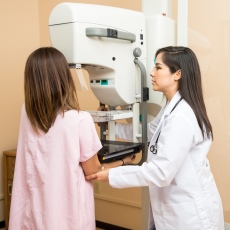
Mammography

MEDICAL ENCYCLOPEDIA
National Institutes of Health
Other Languages
A mammogram is an x-ray picture of the breast. It can be used to check for breast cancer in women who have no signs or symptoms of the disease. It can also be used if you have a lump or other sign of breast cancer.
Screening mammography is the type of mammogram that checks you when you have no symptoms. It can help reduce the number of deaths from breast cancer among women ages 40 to 70. But it can also have drawbacks. Mammograms can sometimes find something that looks abnormal but isn't cancer. This leads to further testing and can cause you anxiety. Sometimes mammograms can miss cancer when it is there. It also exposes you to radiation. You should talk to your doctor about the benefits and drawbacks of mammograms. Together, you can decide when to start and how often to have a mammogram.
Mammograms are also recommended for younger women who have symptoms of breast cancer or who have a high risk of the disease.
When you have a mammogram, you stand in front of an x-ray machine. The person who takes the x-rays places your breast between two plastic plates. The plates press your breast and make it flat. This may be uncomfortable, but it helps get a clear picture. You should get a written report of your mammogram results within 30 days.
NIH: National Cancer Institute
- Mammography and Other Screening Tests for Breast Problems (American College of Obstetricians and Gynecologists) - PDF
- Accuracy of Mammograms (Susan G. Komen for the Cure)
- Dense Breasts (American College of Radiology, Radiological Society of North America)Also in Spanish
- Dense Breasts: Answers to Commonly Asked Questions
 (National Cancer Institute)Also in Spanish
(National Cancer Institute)Also in Spanish - Mammography for Women with Breast Implants (American Cancer Society)Also in Spanish
- Mammography: What You Need to Know (Food and Drug Administration)Also in Spanish
- Nipple Aspirate Test Is Not An Alternative To Mammography (Food and Drug Administration)Also in Spanish
- Thermogram No Substitute for Mammogram (Food and Drug Administration)Also in Spanish
- What Does the Doctor Look for on a Mammogram? (American Cancer Society)Also in Spanish
- Breast Tomosynthesis (American College of Radiology, Radiological Society of North America)Also in Spanish
- Frequently Asked Questions about Digital Mammography (Food and Drug Administration)
- Galactography (Ductography) (American College of Radiology, Radiological Society of North America)Also in Spanish
- Scintimammography (Breast Specific Gamma Imaging-BSGI) (American College of Radiology, Radiological Society of North America)Also in Spanish
- Experimental and Other Breast Imaging Methods (American Cancer Society)Also in Spanish
- FastStats: Mammography/Breast Cancer (National Center for Health Statistics)
- MQSA National Statistics (Food and Drug Administration)
- Women with Disabilities and Breast Cancer Screening (Centers for Disease Control and Prevention)
- ClinicalTrials.gov: Mammography
 (National Institutes of Health)
(National Institutes of Health)
- Article: Breast lesion size assessment in mastectomy specimens: Correlation of cone-beam breast-CT,...
- Article: Use of preoperative mammography, ultrasonography, and MRI to predict nipple areolar...
- Article: Optimism may moderate screening mammogram frequency in Medicare: A longitudinal study.
- Mammography -- see more articles
- American Cancer Society
- Mammography Facilities (Food and Drug Administration)
- National Breast and Cervical Cancer Early Detection Program (NBCCEDP): Find a Screening Provider Near You (Centers for Disease Control and Prevention)
- National Cancer Institute
 Also in Spanish
Also in Spanish
- Mammogram - calcifications (Medical Encyclopedia)Also in Spanish
- Mammograms (Food and Drug Administration) - PDF
- Mammography (Medical Encyclopedia)Also in Spanish






















.png)











No hay comentarios:
Publicar un comentario